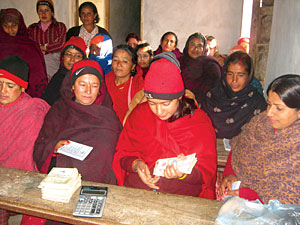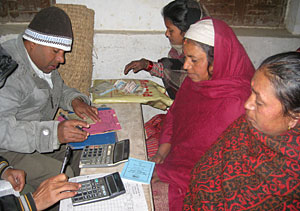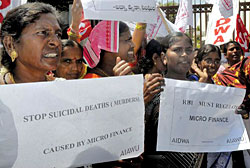 |
Twenty-seven-year-old Kamala Pariyar of Lamatar owns a tailor's shop with three sewing machines and a cupboard of cloth for her clients to choose from. Until six years ago, Pariyar would spend her time looking for sewing jobs at other tailors' businesses. With help from DEPROSC, a microfinance institution, she has started out on her own.
"I started with a loan of Rs 10,000," says Pariyar. "Now the earnings from my shop are enough for my household expenditures, my child's school fees, and I have savings as well. I am much happier."
Pariyar is one of the 1.7 million Nepalis who have benefited from the unique concept of microfinance. Known popularly as 'banking for the poor', the core idea behind microfinance is the provision of collateral-free, small loans that aim to reduce poverty among borrowers.
"Microfinance is an instrument against poverty," says Harihar Dev Pant of Nirdhan Uthan Bank. "And I would say that we in Nepal have been able to successfully replicate the model of microfinance to reach its objectives."
 HANDS FULL: DEPROSC clients in Lamatar meet monthly to pay their installments, check on savings, and share experiences. |
Microfinance services here are provided chiefly through microfinance development banks, NGOs, and cooperatives. These institutions operate in over 55 districts, extending financial services to those who did not have access to them earlier. Average loan size is Rs 15,000, usually to be paid back over the period of a year. Institutions claim an impressive recovery rate of over 98 per cent.
Cases of default are rare because instead of servicing individual clients, microfinance institutions in Nepal form groups of borrowers. In the absence of collateral against loans, it is the group that acts as the guarantor and a borrower feels morally obliged to pay his or her loans back on time. Microfinance institutions, recognising that financial management is especially difficult for those unused to banks, go step by step with their clients. They first provide prospective clients with financial training, then monitor them closely through monthly meetings. "When a member of a borrowers' group is unable to pay, everyone pitches in," says Lok Hari Koirala, who works with DEPROSC Nepal. "This instills a collective sense of responsibility."
 |
The challenge now is to ensure that the profit motive does not affect the commitment of those investing in microfinance in Nepal. Social responsibility is key to microfinance, and those implementing it should ensure the tragedy of Andhra Pradesh (see box) is not repeated here.
Mission drift
 |
The legislation followed reports in October this year of over 80 suicides in the state, triggered by high interest rates and aggressive debt collection techniques by microfinance institutions. While it was taken to stop exploitation of poor borrowers, the legislation has in turn meant borrowers have stopped paying loans, crippling the microfinance industry.
Muhammad Yunus, the Bangladeshi economist who won the Nobel Peace Prize in 2006 for his Grameen Bank's pioneering work in microfinance, admitted the reputation of microcredit had been tarnished due to Indian commercial companies that charge high interest rates and allegedly use heavy-handed tactics to collect repayments. "It's a complete detour and nothing but a quitting of the mission of microfinance," Yunus said, responding to the crisis. "The original microcredit concept cannot be blamed for their faults."
High finance
While microfinance has been very successful in the Tarai, the challenge now is to move to the hills and the mountains. "Institutions are reluctant to go to these areas because of the high cost of operation," says Shankar Man Pradhan of the Rural Microfinance Development Centre (RMDC), a wholesale lender to microfinance institution. Settlements tend to be more scattered in the hills and the options for income-generating activities to be taken up with the help of loans are fewer than in the Tarai.
Nonetheless, microfinance institutions are beginning to acknowledge this service gap and some are now taking the initiative to extend their services into more difficult terrain. RMDC has been trying to incentivise organisations to begin work in the hills by providing loans with interest at only 2 per cent. Co-operatives like Himchuli Krishi, Hatemalo and Kasthuri have already taken up the gauntlet and are now working in the villages of Kalikot, Accham and Jajarkot.
READ ALSO:
Helping workers abroad
"Rebuild the t-r-u-s-t", INTERVIEW


